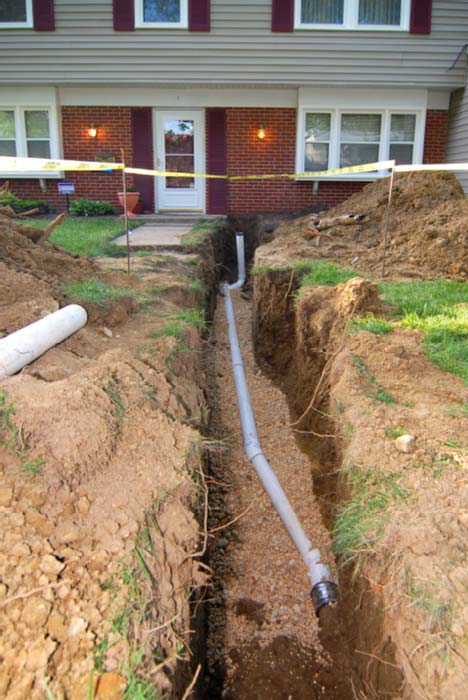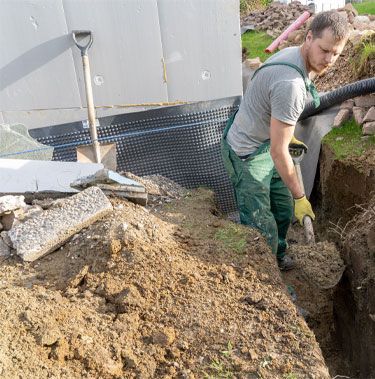Maintain Your Basement Dry with a Properly Set Up French Drain System
Maintain Your Basement Dry with a Properly Set Up French Drain System
Blog Article
Understanding the Relevance of a Sewage-disposal Tank French Drainpipe for Effective Wastewater Monitoring
The assimilation of a septic storage tank French drainpipe system plays an essential role in efficient wastewater monitoring, yet its value is usually neglected. Recognizing the auto mechanics and advantages of such a system can illuminate its important duty in avoiding soil saturation and enhancing groundwater quality.
What Is a Sewage-disposal Tank French Drain?
A sewage-disposal tank French drain is a specific water drainage system made to take care of wastewater and avoid flooding in areas where traditional drain techniques might be poor. This system incorporates the functionalities of a typical septic container with a French drainpipe, enabling effective wastewater treatment and effective water diversion.

Built making use of perforated pipes laid in crushed rock trenches, a French drain promotes the activity of water far from vital locations. It permits the infiltration of excess water into the bordering dirt, advertising efficient drain while securing the septic tank's stability. The mix of these two systems is specifically advantageous in regions with hefty rains or poor water drainage, making certain the long life and capability of wastewater administration systems while securing public health and wellness and the environment.

Exactly How It Functions in Wastewater Management
In wastewater administration, the combination of a septic system and French drainpipe plays an important function in making certain efficient treatment and disposal of sewage. The sewage-disposal tank acts as the very first line of defense, where wastewater goes through preliminary treatment with sedimentation and anaerobic digestion. Solids work out near the bottom, creating sludge, while lighter products, such as grease and oils, float to the top, producing a residue layer. This procedure lowers the natural tons of the wastewater before it moves onward.
Once the wastewater is clarified, it moves into the French drainpipe system, which is made to promote additional treatment and secure dispersal. The French drainpipe consists of perforated pipelines buried in gravel or rock, enabling cured effluent to percolate right into the bordering soil. This all-natural filtering procedure help in the elimination of virus and nutrients, promoting groundwater recharge and reducing the threat of surface area contamination.
With each other, the septic system and French drain create a lasting technique to wastewater management, reducing ecological effect while guaranteeing compliance with health policies. This integrated system not just protects public health and wellness however also preserves the integrity of regional communities.
Benefits of a French Drain System

The French drain system supplies various benefits that enhance both wastewater management and environmental management. Primarily, it efficiently redirects water away from essential locations, minimizing the risk of flooding and dirt saturation that can compromise septic tanks. This positive drain solution helps keep the integrity of the septic system by stopping excess wetness, which can lead to system failure.
Furthermore, a correctly installed French drainpipe minimizes the possibility for groundwater contamination. By carrying wastewater away from the residential or commercial property, it decreases the chance of pollutants entering local water sources, therefore securing public health and wellness and keeping ecological balance. The system also boosts the aesthetic appeals and performance of exterior spaces by protecting against water accumulation, which can develop unpleasant pools or sloppy areas.
Furthermore, French drains call for fairly reduced upkeep contrasted to various get more other drainage services, making them a cost-effective lasting financial investment. Their versatility allows them to be used in different landscapes, suiting both domestic and industrial residential properties. Inevitably, the advantages of a French drainpipe system expand past immediate water drainage needs, adding to lasting wastewater monitoring practices and promoting ecological stewardship.
Common Concerns Without a French Drainpipe
Overlooking the installation of a French drain can cause considerable difficulties in handling water flow and preserving soil integrity. Among the main concerns is the build-up of excess surface water, which can develop flooding or merging in lawns, especially after hefty rainfall. This torpidity can fill the soil, leading to disintegration and jeopardizing the foundation of nearby structures.
Moreover, without a French drainpipe, groundwater can incorrectly penetrate septic tanks, boosting the danger of system failure. The resulting backup can bring about undesirable odors, wellness threats, and pricey fixings. Poor water drainage can additionally promote the development of mold and mildew and mold, which can negatively affect interior air top quality and position health dangers to owners.
Inevitably, the absence of a French drain can result in a variety of ecological and structural concerns that require considerable intervention and expense to fix. Implementing a French drainpipe system is vital for effective wastewater monitoring and residential or commercial property protection.
Maintenance Tips for Homeowners
Normal upkeep of a French drainpipe is vital to ensure its ideal efficiency and durability. If debris is existing, take into consideration utilizing a high-pressure water jet to get rid of the drainpipe.
Additionally, it is important to keep the area around the French drain without particles, such as fallen leaves, soil, and other organic issue. This will certainly avoid clogging and enable efficient water drain. Consistently trimming plants and growing far from the drain can additionally mitigate root intrusion.
Moreover, home owners need to check the performance of their French drain after hefty rains. Observing how well water is directed away from the click reference septic system can supply understandings right into its performance. It may indicate a requirement for expert analysis. if merging water is noted.
Finally, consider scheduling regular expert assessments to assess the general problem of the drainpipe. Such proactive steps will aid maintain the effectiveness of your French drain and guarantee effective wastewater monitoring for many years to come.
Conclusion
In conclusion, the septic tank French drainpipe system plays an important role in reliable wastewater monitoring by ensuring correct treatment of Learn More Here sewage and reliable water diversion. Overall, the septic storage tank French drainpipe stands for a sustainable remedy that profits both business and domestic residential properties throughout different landscapes.
The integration of a septic tank French drainpipe system plays a pivotal duty in effective wastewater administration, yet its importance is typically overlooked. Ultimately, the benefits of a French drainpipe system expand past prompt water drainage demands, contributing to lasting wastewater monitoring methods and promoting environmental stewardship.
Moreover, without a French drain, groundwater can improperly penetrate septic systems, enhancing the threat of system failing - French Drain System. Carrying out a French drain system is essential for efficient wastewater management and home protection
In verdict, the septic container French drain system plays a vital function in reliable wastewater administration by ensuring correct treatment of sewage and effective water diversion.
Report this page